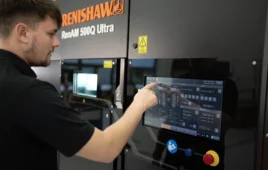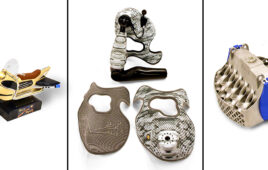The ability to get a design into the hands of its users, in this case, physicians, leads to faster design iteration and development.
For Kablooe Design, creating devices that transform the medical industry is not a new endeavor. Nearly 75% of the Minneapolis firm’s creations are medical devices that have changed the way patients are treated, significantly improving quality of life for thousands of people.
A 3D rendering of the working prototype. Kablooe engineers were charged with developing a device that would be minimally invasive. The device will inject a tiny needle, then a steam vapor into the prostate that gently denatures the cell membranes of the prostate, allowing the cells to die and the prostate to shrink. Patients can be back to normal urinary function within a matter of hours.
Recently a medical technology company approached Kablooe for assistance in the development of a device that would transform the procedure for Benign Prostatic Hyperplasia (BPH). Prior to this device, BPH surgery (TURP or transurethral resection of the prostate) involved inserting a resectoscope into the urethra where the overgrown prostate tissue is cut away using an electric current. The urethral lining is also removed during the procedure, leaving many patients with bleeding, scaring, and the need for a short hospital stay. Post-procedure patients often require a urinary catheter for an extensive period of time – some never regain regular urinary function again.
This new device could offer patients a minimally invasive procedure; no cutting, no bleeding. The device injects a tiny needle, then a steam vapor into the prostate that gently denatures the cell membranes of the prostate, allowing the cells to die and the prostate to shrink. Patients can be back to normal urinary function within a matter of hours.
The Kablooe engineering team had to invent many mechanical functions for this device; including: a saline flush, vapor delivery, a needle deploy and retract function, a drain function, a video adapter, and a rotation mechanism. The team had to mechanically design, invent, and discover how all these functions were going to work in a handheld tool connected to a generator unit.
RedEye FDM print in action. The design team knew that alternatives to FDM would be too brittle for use on the medical device.
The development of the device would require a rapid prototyping method that would allow lessons to be learned and changes to be made quickly. And the new device would require a durable plastic enclosure that houses complex computer and motor components. The designers estimated they would need seven to ten iterations to get the design perfected. And they knew they would be required to perform product feasibility testing for the FDA.
With all this in mind, it would not have been feasible to spend the hundreds of thousands of dollars to make traditional injection molded tooling on early designs, only to find that changes would have to be made. According to Tom KraMer, president, Kablooe Design, “The device is complicated. It has RF energy generators, computer circuit boards, and power transformers. It is a complex geometry that will need to be tested for EMI (elecromechanical interference) and against UL (Underwriters Laboratories) standards prior to manufacturing.”
A disassembled prototype with FDM parts. The development of the device required rapid prototyping so that the engineering team could make changes quickly. The device would require a durable plastic enclosure to house complex computer and motor components. The designers estimated they would need seven to ten iterations to get the design perfected.
The design team worked in collaboration with other groups responsible for making changes to the circuit boards and other components for this device. As the engineers received specifications for changes to these components, ABS models built with FDM® (Fused Deposition Modeling) allowed them to aptly modify the device. FDM is a 3D printing/additive manufacturing process that builds plastic parts layer by layer from production-grade plastic material, using data from CAD files.
The company does not own an FDM machine, so they chose to print functional prototypes through RedEye On Demand, which provides rapid prototyping and direct digital manufacturing services with a global network of more than 100 systems.
Familiar with various rapid prototyping methods, the design team knew that alternatives to FDM would be too brittle for use on this device. Traditional tooling and injection molding would be far too costly and time consuming. The prototypes had to use FDM with ABS plastics because the plastic had to endure complex and heavy components being screwed and mounted into the device. It had to be strong enough for drop testing while also maintaining a level of aesthetic appeal. Because FDM models are made from the same tough thermoplastics used in injection molding, they are able to withstand rigorous testing. If the designers had chosen other prototyping methods like SLA, their model would have cracked or even shattered during testing.
Kablooe engineer designing prototype device with 3D software.
Ordering FDM models through RedEye On Demand during the prototyping process saved $250,000.00 and 12 weeks of time. The team was able to print a model, test the mechanics and human factors of the device, quickly make changes and reprint their model as they improved upon their design. FDM allowed for the discovery of dozens of things that needed to be perfected in the model before it was sent to production. For example, the team went through four prototypes of the handheld unit. The use of FDM allowed them to put together a functioning unit to test in animal trials and bench testing. The team originally designed the handheld unit in a cylindrical form like a catheter handle. They discovered through feedback from physicians and technicians that operators preferred a pistol shaped grip. Printing a working prototype helped get the device into the hands of physicians so that they could in turn quickly provide feedback. With RedEye, the team didn’t have to invest in capital equipment. They only paid for the units they printed. MPF
RedEye On Demand
www.redeyeondemand.com
Filed Under: Make Parts Fast




